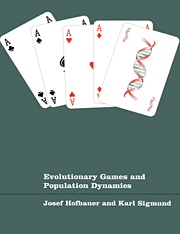Book contents
- Frontmatter
- Contents
- Preface
- Introduction for game theorists
- Introduction for biologists
- About this book
- Part one Dynamical Systems and Lotka–Volterra Equations
- 1 Logistic growth
- 2 Lotka–Volterra equations for predator–prey systems
- 3 The Lotka–Volterra equations for two competing species
- 4 Ecological equations for two species
- 5 Lotka–Volterra equations for more than two populations
- Part two Game Dynamics and Replicator Equations
- Part three Permanence and Stability
- Part four Population Genetics and Game Dynamics
- References
- Index
1 - Logistic growth
Published online by Cambridge University Press: 05 June 2012
- Frontmatter
- Contents
- Preface
- Introduction for game theorists
- Introduction for biologists
- About this book
- Part one Dynamical Systems and Lotka–Volterra Equations
- 1 Logistic growth
- 2 Lotka–Volterra equations for predator–prey systems
- 3 The Lotka–Volterra equations for two competing species
- 4 Ecological equations for two species
- 5 Lotka–Volterra equations for more than two populations
- Part two Game Dynamics and Replicator Equations
- Part three Permanence and Stability
- Part four Population Genetics and Game Dynamics
- References
- Index
Summary
Some of the simplest models for the dynamics of a single population exhibit very complicated behaviour, including bifurcations and chaos.
Population dynamics and density dependence
One of the major tasks of mathematical ecology is to investigate the dynamics of population densities. In many ecosystems, thousands of different species interact in complex patterns. Even the interactions between two species can be quite complicated, involving the effects of seasonal variations, age structure, spatial distribution and the like. In the following, we shall exclusively investigate the effects of density dependence. As a first approximation, we may distinguish here three basic situations.
(a) Competition. Two species may be rivals in the exploitation of a common resource. The more there is of one species, the worse for the other. Because of the importance of competition as a limiting factor in evolution, such situations have attracted considerable attention.
(b) Mutualism. This is the reverse situation: the species benefit from each other. The more there is of one species, the better for the other. This is the case for lichen, a coalition between algae and fungi, or for the strange partnership between hermit crabs and sea anemones.
(c) Host–parasite relationship. The situation, here, is asymmetrical. The parasites benefit from the host but they do it no good. In this sense, predators can be viewed as parasites of their prey. (For a parasite, however, the host is not only a resource, but also a means for spreading.)
- Type
- Chapter
- Information
- Evolutionary Games and Population Dynamics , pp. 3 - 10Publisher: Cambridge University PressPrint publication year: 1998

